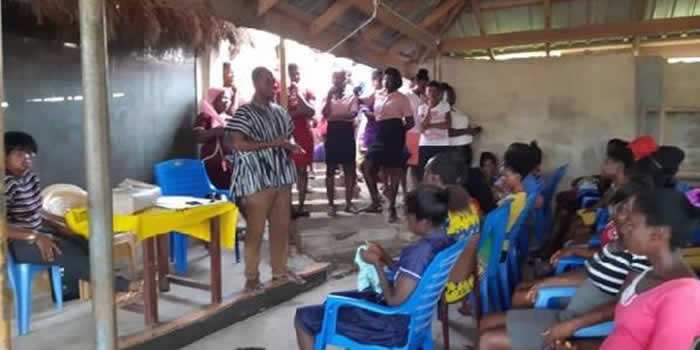

Introduction
Demographic characteristics including population size, distribution and age-sex structure are necessary inputs for effective planning for socio-economic development of a country. These characteristics are influenced by the components of population change i.e. fertility, mortality and migration. The dynamics of the components of population change have numerous demographic and socio-economic implications for development.
The objective of this chapter is to discuss the population size and distribution, sex ratio and the population pyramid of the Mpohor District. Also discussed in this chapter are the dynamics of the components of population change of the District.
Population Size and Distribution
Mpohor District has a total population of 42,923 consisting of 21,486 males and 21,437 females as shown in Table 2.1. The District is predominantly rural with 74.8 percent of the residents in the villages. Figure 2.1 shows that, the population among urban and rural localities are 74.8 percent and 25.2 percent respectively. This shows that majority of the population in the District reside in the rural communities
Age-Sex Structure, Sex Ratio and Population Pyramid
Age and sex structure of a population are vital characteristics of a population which influence many demographic issues. Understanding the age and sex structure of a population yields insights into the dynamics of the population composition and highlights on socio-economic challenges
Age-sex structure
The age-sex structure which is useful for population projections is presented in Table 2.1. Forty percent of the total population of the District is in the 0-14 age group. The District has a sex ratio of 100.2. The sex ratio for the people in the 25-64 age group and 65+ is less than 100 which means that there are more females than males among those age groups.
Age-Dependency Ratio
Age-dependency ratio is a measure of the dependent population made up of those below 15 years and 65+ years, to the independent population, that is, those in the 15-64 years. The ratio is used to measure the burden borne by those in the working age group. According to Table 2.1, the age-dependency ratio for the District is 78.8. The ratio is higher for males (79.7) than females (77.9) and in the rural (81.4) than the urban (71.5) areas in the District.
Population Pyramid
Population pyramid is a graphical representation of the age-sex composition of a population. Figure 2.1 shows the population pyramid of the Mpohor District. The pyramid which has abroad base and tapers off with increasing age depicts a youthful population similar to that of the country. This is because in typical developing country like Ghana fertility rate tends to be relatively high and the average life expectancy low accounting for the broad base and narrower upper end of the population pyramid. As shown in Figure 2.1 there are no marked differences in the number of males and females in the various age groups with the exception of the 70+ olds with a higher female population.
Fertility, Mortality and Migration
Fertility, mortality and migration are factors that influence population growth at a particular point in time. Data on these three components are critical for planning the overall socio-economic development of the District.
In this section, we examine the components of population change – fertility, mortality and migration. The interactions of these components determine the size and structure of population. While fertility causes an increase in the size of the population through births, mortality on the other hand leads to a reduction in the size of the population through deaths. Unlike fertility which causes an increase at only one point – births of persons aged zero, deaths can occur at any age, although the force of mortality is greater at the very young and older ages. Similarly, migration can occur at any age, but it is usually young adult males who move first and are often joined by their families. However, unlike fertility and mortality, migration affects the population size and structure of two Regions, the area of in-migration as well as the area of out-migration.
Fertility
Table 2.3 presents various fertility measurements, namely, Crude Birth Rate (CBR), General Fertility Rate (GFR), and Total Fertility Rate (TFR). Generally, fertility level for the District is higher than the average for the Western Region. The District has a TFR of 4.3 and a GFR of 125.8 which is far higher than the regional average of 105.8.
Children ever born and children surviving
Again, the fertility dynamics of the female population 12 years and older in the Mpohor District is presented in Table 2.4. There are 14,425 females 12 years and older in the District with the highest number (2,051) and the lowest number (468) in the 15-19 and 55-59 age groups respectively. Children ever born to females 12+ years is 40,081 consisting of 19,892 males and 20,189 females. The 60+ and the 12-14 age groups registered the highest and the lowest number of children ever born respectively. There is no discernable pattern of the children ever born by sex. The number of reported surviving children in the District is a reflection of the number of children ever born as shown in Table 2.3.
Mortality
Data on mortality provide an indication of the health status of the population as well as measure of the living conditions of the people. It also provides information on the potential growth of the population in the future. Several interventions over the years, including enhancing access to quality health care services, improving food security and improving environmental conditions, among others have been done by government and development agencies to reduce the prevailing high levels of mortality. Mortality during the 2010 PHC took into consideration crude death rates and age specific death rate in the Mpohor District. Alternatively, mortality refers to the incidence of death or the number of deaths in a population. Mortality Rates are generally expressed as the number of deaths per 1000 individuals per year.
Mortality data in Table 2.5 refers to all deaths that occurred in the household during the 12 months preceding the census night. The report shows information on deaths in household due to accidents, violence, homicide and suicide. The Mpohor District is among the Districts in the Western Region with high Crude Death Rates (CDR). The CDR of 9.1 for the Mpohor District is higher than the 6.2 for the Western Region (Table 2.4). The number of registered deaths in households in the District of 390 is relatively low partly due to the District population size.
Age-Specific Death Rates (ASDRS)
Age-specific death rate by sex is the number of deaths per age group by male and female populations. Figure 2.3 shows age specific death rates for the District. Figure 2.2 shows reported age specific death rates by sex. Infant mortality and under-five mortality rates are higher among females than males in the Mpohor District. The death rate among females aged 15 -39 years and 44-54 is also higher than males, a possible indication of relatively high maternal mortality in the District. Figure 2.2 further shows that the age specific death rates for males aged 55 years and above are higher than that of females in the same age groups.
Distribution on causes of death
Table 2.6 shows the number of deaths in households. According to the Table, 390 deaths were recorded in households for the last 12 months. While the region recorded higher percentages of 13.4 percent deaths due to accidents/homicide/suicide or violence, the District recorded a lower percentage (11.3%) of death due to accidents/homicide/suicide/violence.
Migration
Table 2.7 shows birthplace by duration of residence of migrants in the Mpohor District. The District registered 14,570 migrants. Majority (56.6%) of the migrants in the District were born outside the Western Region. Of the migrants who were born outside the Western Region, the majority, 28.1 percent were born in the Central Region and 7.6 from the Ashanti Region.
The highest proportion of 28.8 percent of migrants has stayed in the District for 1-4 years. The duration of residence varies by the region of birth. For instance, the highest proportion (24.7%) of the migrants who were born in the Central Region has stayed for 1-4 years while 30.7 percent of those born in the Eastern Region have stayed for 20+ years.
Date Created : 11/20/2017 5:25:31 AM









 facebook
facebook
 twitter
twitter
 Youtube
Youtube
 +233 593 831 280
+233 593 831 280 0800 430 430
0800 430 430 GPS: GE-231-4383
GPS: GE-231-4383 info@ghanadistricts.com
info@ghanadistricts.com Box GP1044, Accra, Ghana
Box GP1044, Accra, Ghana